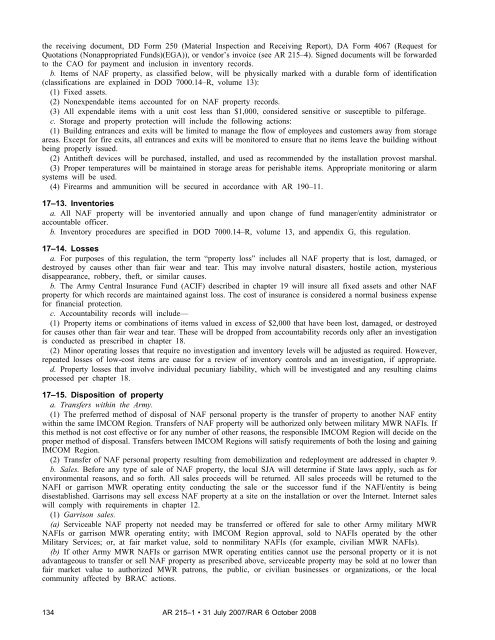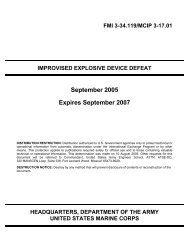AR 215-1 - Soldier Support Institute - U.S. Army
AR 215-1 - Soldier Support Institute - U.S. Army
AR 215-1 - Soldier Support Institute - U.S. Army
You also want an ePaper? Increase the reach of your titles
YUMPU automatically turns print PDFs into web optimized ePapers that Google loves.
the receiving document, DD Form 250 (Material Inspection and Receiving Report), DA Form 4067 (Request for<br />
Quotations (Nonappropriated Funds)(EGA)), or vendor’s invoice (see <strong>AR</strong> <strong>215</strong>–4). Signed documents will be forwarded<br />
to the CAO for payment and inclusion in inventory records.<br />
b. Items of NAF property, as classified below, will be physically marked with a durable form of identification<br />
(classifications are explained in DOD 7000.14–R, volume 13):<br />
(1) Fixed assets.<br />
(2) Nonexpendable items accounted for on NAF property records.<br />
(3) All expendable items with a unit cost less than $1,000, considered sensitive or susceptible to pilferage.<br />
c. Storage and property protection will include the following actions:<br />
(1) Building entrances and exits will be limited to manage the flow of employees and customers away from storage<br />
areas. Except for fire exits, all entrances and exits will be monitored to ensure that no items leave the building without<br />
being properly issued.<br />
(2) Antitheft devices will be purchased, installed, and used as recommended by the installation provost marshal.<br />
(3) Proper temperatures will be maintained in storage areas for perishable items. Appropriate monitoring or alarm<br />
systems will be used.<br />
(4) Firearms and ammunition will be secured in accordance with <strong>AR</strong> 190–11.<br />
17–13. Inventories<br />
a. All NAF property will be inventoried annually and upon change of fund manager/entity administrator or<br />
accountable officer.<br />
b. Inventory procedures are specified in DOD 7000.14–R, volume 13, and appendix G, this regulation.<br />
17–14. Losses<br />
a. For purposes of this regulation, the term “property loss” includes all NAF property that is lost, damaged, or<br />
destroyed by causes other than fair wear and tear. This may involve natural disasters, hostile action, mysterious<br />
disappearance, robbery, theft, or similar causes.<br />
b. The <strong>Army</strong> Central Insurance Fund (ACIF) described in chapter 19 will insure all fixed assets and other NAF<br />
property for which records are maintained against loss. The cost of insurance is considered a normal business expense<br />
for financial protection.<br />
c. Accountability records will include—<br />
(1) Property items or combinations of items valued in excess of $2,000 that have been lost, damaged, or destroyed<br />
for causes other than fair wear and tear. These will be dropped from accountability records only after an investigation<br />
is conducted as prescribed in chapter 18.<br />
(2) Minor operating losses that require no investigation and inventory levels will be adjusted as required. However,<br />
repeated losses of low-cost items are cause for a review of inventory controls and an investigation, if appropriate.<br />
d. Property losses that involve individual pecuniary liability, which will be investigated and any resulting claims<br />
processed per chapter 18.<br />
17–15. Disposition of property<br />
a. Transfers within the <strong>Army</strong>.<br />
(1) The preferred method of disposal of NAF personal property is the transfer of property to another NAF entity<br />
within the same IMCOM Region. Transfers of NAF property will be authorized only between military MWR NAFIs. If<br />
this method is not cost effective or for any number of other reasons, the responsible IMCOM Region will decide on the<br />
proper method of disposal. Transfers between IMCOM Regions will satisfy requirements of both the losing and gaining<br />
IMCOM Region.<br />
(2) Transfer of NAF personal property resulting from demobilization and redeployment are addressed in chapter 9.<br />
b. Sales. Before any type of sale of NAF property, the local SJA will determine if State laws apply, such as for<br />
environmental reasons, and so forth. All sales proceeds will be returned. All sales proceeds will be returned to the<br />
NAFI or garrison MWR operating entity conducting the sale or the successor fund if the NAFI/entity is being<br />
disestablished. Garrisons may sell excess NAF property at a site on the installation or over the Internet. Internet sales<br />
will comply with requirements in chapter 12.<br />
(1) Garrison sales.<br />
(a) Serviceable NAF property not needed may be transferred or offered for sale to other <strong>Army</strong> military MWR<br />
NAFIs or garrison MWR operating entity; with IMCOM Region approval, sold to NAFIs operated by the other<br />
Military Services; or, at fair market value, sold to nonmilitary NAFIs (for example, civilian MWR NAFIs).<br />
(b) If other <strong>Army</strong> MWR NAFIs or garrison MWR operating entities cannot use the personal property or it is not<br />
advantageous to transfer or sell NAF property as prescribed above, serviceable property may be sold at no lower than<br />
fair market value to authorized MWR patrons, the public, or civilian businesses or organizations, or the local<br />
community affected by BRAC actions.<br />
134 <strong>AR</strong> <strong>215</strong>–1 • 31 July 2007/R<strong>AR</strong> 6 October 2008

















